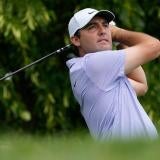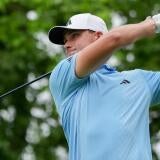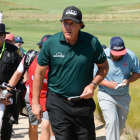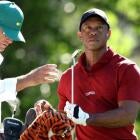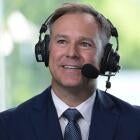2018 U.S. Open: Follow Round 4 leaderboard action live
SOUTHAMPTON, N.Y. -- The year is 2021. Tiger Woods is playing in the final twosome at Augusta National, trying to win his his fifth green jacket. He is paired with Jordan Spieth and leading the field by three strokes as the pair steps to the 9th tee box. Woods has just eagled the 8th hole, and Augusta is vibrating. After an obliterated drive that starts to climb the slope in front of the 9th green, Woods chips his next shot past the hole. He has a wicked 11-footer for birdie and a four-stroke lead heading to the second nine.
He misses it badly. So badly, in fact, that as the ball runs past the hole, he runs to catch up with it and pulls his Scotty Cameron back while the ball is still rolling. When it gets 2 feet past the hole, he pops it in for a par. The ball was clearly going to roll all the way off the false front on No. 9 and back down the fairway where he would once again have a tricky pitch shot. So Woods figured, instead of trying to chip all the way up from down there and two putt for a double bogey, he would just take the two-stroke penalty for double and move to the second nine with a one-stroke lead over Spieth, who parred the 9th.
To paraphrase a certain dynastic football coach: Is this what we want golf to be?
It's certainly what the USGA on Saturday has confirmed it could be when they allowed Phil Mickelson to more or less do what I described above in Round 3 of the 2018 U.S. Open. Mickelson didn't make his putt on a still-moving ball, and he wasn't leading a major championship, but that hardly matters.
Rule 14-5 -- a player must not make a stroke at his ball while it is moving -- was applied, which to me was a trap door for the USGA to sneak out while nobody was looking. Rule 14-5 is sandwiched by other rules that apply to golf balls that are minutely moving around a player. Think of a ball oscillating on the green or dancing on the fairway in a healthy windstorm. It was not created to address what Mickelson did, which looked like a move one of my kids would make while playing miniature golf. In fact, there is a clause in Rule 14-5 for exactly what Mickelson did: Ball purposely deflected or stopped by player, partner or caddie -- see Rule 1-2.
Rule 1-2 is applied in situations like Mickelson's where a player is purposefully altering a previous shot. But the language in the rule doesn't make room for a player making a stroke on such a shot mostly because nobody within reason would have ever expected this kind of thing to happen. It only states that a player can't deflect or stop a shot, which is basically of what he did. So Mickelson wriggles through a preposterous loophole (not his first or last loophole wriggle!) because he pulled his club back and made a stroke. Maybe I'm wrong, but Rule 14-5 does not appear to have been created for this type of situation. That's why Rule 1-2 exists.
Would you feel differently if Dustin Johnson had picked up his drive on the 3rd hole on Saturday and walked it to within a foot of the cup, set it down and tapped it in? Philosophically speaking, that's what Mickelson did. He gained an advantage by breaking the rules. He admitted he did it on purpose. If you follow Rule 1-2 to its end, the proper punishment is disqualification. It's a clear path to that end.
The USGA chose not to take it.
A remarkable sequence on Hole 13, where Phil Mickelson was assessed a two-stroke penalty for hitting a moving ball and ended up making a 10 on the hole. pic.twitter.com/kx6ieYiOGR
— U.S. Open (USGA) (@usopengolf) June 16, 2018
Was it awesome and hilarious that Mickelson did this? Yes, of course. Everything Mickelson does is awesome and hilarious. Did it affect the event? No, of course not. Mickelson finished his third round 17 over and 14 back of the leaders. It has no bearing on this event. However, as my colleague Dylan Dethier pointed out, it also an atrocious precedent that could theoretically affect future tournaments or major championships.
That's the issue. That's what is at stake.
The first reaction was to view this like J.R. Smith running out the clock with Game 1 of the 2018 NBA Finals tied late -- hilarious, irreverent and so on brand it hurts. More appropriately, it would be J.R. kicking a ball going out of bounds underneath his opponent's basket down the court to a wide-open LeBron James with James missing the ensuing shot. By rule, a play the officials should whistle dead once the ball is kicked. No harm, no foul, right? Just technically not allowed.
The other problem here is with the actual rule book. I know it's shocking that the convoluted rules of golf both (a) Don't cover this specific instance, and (b) Allow linguistic gymnastics to acquit one of the 10 best players of all time. But that's where we're at. Of course, it wouldn't be a U.S. Open if we all didn't spend at least half of one day parsing through all 9,000 pages of the rule book. I understand that you can't legislate every situation, but that's exactly what makes this entire thing more absurd. The USGA exists to sort out situations like this one. They keep making the wrong choices.
I feel like a curmudgeon here. I understand why people are triggered by the stuffiness of golf and enjoy Mickelson having a little fun with all of this, even if it was like watching a crazy uncle whip roman candles around a gaggle of nieces and nephews on July 4th. Ha-ha-ha ... ha-ha-ha … wait, is this a good idea? Mickelson's zaniness covers over a multitude of sins. This is what he does, who he is.
"Imagine if that had been Patrick Reed," one media member quipped to me.
Chaos is my drug of choice at events like these. I crave it. I can't get enough of it. But the reality of this situation is this: While I'm sort of glad Lefty did what he did and enjoyed watching the entire thing (including his semi-surreal press conference) unfold, the USGA should have stepped in and disqualified him from the tournament.
They could have easily done so under Rule 33-7. It is, somewhat humorously, what kept Tiger Woods in the field when he hit the pin in 2013 at Augusta National and took a bad drop. You remember that one, yes? Here is Rule 33-7.
A penalty of disqualification may in exceptional individual cases be waived, modified or imposed if the Committee considers such action warranted. Any penalty less than disqualification must not be waived or modified. If a Committee considers that a player is guilty of a serious breach of etiquette, it may impose a penalty of disqualification under this Rule.
I don't necessarily hold Mickelson accountable for much of this. He momentarily lost his mind and did something he shouldn't have done. He's played in 27 of these U.S. Opens and never claimed victory. A mere mortal would have snapped about a decade ago. The outcry of support for him is also well-intentioned, I suppose, even if misplaced. The fallout from Saturday was fascinating to observe. We live in this anti-authoritarian world in which two seemingly conflicting truths cannot be held in one's hand at the same time. Gray issues are split down the middle with black and white sides taken up. It's not possible for us to affirm both.
What happened Saturday could reverberate, though. For Mickelson, over the rest of his career. For players, in the way they view him. And also at future tournaments and major championships. Controlling chaos is not the job of the players or the fans. It's the job of the folks running this event.
Mickelson's putt, on one hand, is not as big of a deal as everyone is making it. It was a moment of madness in a tournament that deals specifically in engendering moments of madness. In that sense, it was perfect. It was peak Phil ... and maybe even peak USGA. I still can't believe it happened. It defined the tournament and maybe the entire week.
But while that truth holds, another must also be considered. Mickelson should have been disqualified. He knows it. We know it. Other players know it. The USGA knows it.
It's difficult to nail these issues in the moment. Everything feels like it's in fast-forward, and the default is toward the conservative play. But everyone got it wrong on Saturday (which, ironically, was part of the fun): Mickelson for what he did, the USGA for its ruling, fans for their full-throated support of an insolent display.
But the whole thing was also kind of wonderful. Such is life in the world of Phil Mickelson.
![[object Object] Logo](https://sportshub.cbsistatic.com/i/2020/04/22/e9ceb731-8b3f-4c60-98fe-090ab66a2997/screen-shot-2020-04-22-at-11-04-56-am.png)



